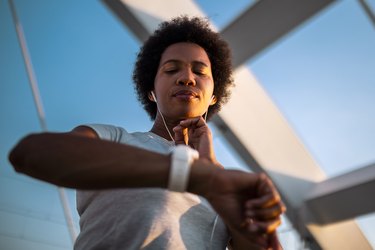
Your heart is a pump that circulates blood — and with it, oxygen and nutrients — throughout your body. When you work out, your muscles need more oxygen and nutrients to use as fuel, so your heart beats faster to power that increased circulation.
Tip
When you work out, your muscles need more oxygen and nutrients to use as fuel. Those are carried in your blood, and your heart is the pump that circulates blood through your body — so during a workout, your heart beats faster to accommodate that increased need.
Video of the Day
Why Your Heart Rate Increases When You Exercise
Your heart is a muscle — and just like the other muscles in your body, it gets stronger with exercise. Kaiser Permanente explains that when your heart gets stronger, it pushes out more blood with every beat — which means it doesn't have to work as hard to circulate adequate oxygen and nutrients when you exercise. So your heart rate will still rise with exercise, but it won't have to rise as much.
Video of the Day
If you've noticed your heart rate jump up really fast, you might wonder: Why does my heart rate increase so quickly while exercising? According to Alberta Health Services, "during exercise, your body may need three or four times your normal cardiac output because your muscles need more oxygen when you exert yourself."
Regular exercise helps the rest of your circulatory system get more efficient too. This includes greater ability to utilize oxygen, better blood flow in small arteries around your heart and an improved cholesterol profile.
Warning
As Kaiser Permanente notes, if you haven't exercised in a long time or have a history of high blood pressure, stroke, dizziness, heart disease or exercise-related pain, you should talk to your doctor before working out.
Your resting heart rate can provide a useful glimpse into your heart health. Count your pulse for 60 seconds, after a good night's sleep and before you get out of bed. The result is your resting heart rate.
As the American Heart Association (AHA) notes, for most people who are sitting or lying down — calm, relaxed and not ill — a normal resting heart rate is 60 to 100 beats per minute (bpm). Your resting heart rate might be lower if you take certain drugs, such as beta blockers.
And if you're wondering, "will my heart rate decrease as I get fitter?" The answer is yes. Athletic people may also have lower resting heart rates, down to about 40 bpm, because their entire circulatory system works more efficiently.
Heart Rate vs. Pulse Rate: What's the Difference?
While most people use these terms interchangeably, there is a slight difference, according to the Cleveland Clinic. Your heart rate is the number of times — or how fast — your heart beats in a minute, whereas your pulse is how you can feel your heart rate.
"Every time your heart beats, it squeezes and propels blood through the network of arteries in your body. Your pulse is the pressure in your arteries going up briefly as your heart pushes out more blood to keep circulation going," the Cleveland Clinic says.
You can feel your pulse in a number of places throughout your body, such as your neck, wrist and the inside of your elbow.
Warning
The AHA warns that if you have a very low pulse or if you have frequent episodes of unexplained fast heart rates — especially if you also feel weak, dizzy or faint — you should consult a doctor to determine whether you're having a medical emergency.
How to Find Your Target Heart Rate
The AHA breaks down the basics of calculating your target exercise heart rate. Start by subtracting your age from 220; the resulting number is your maximum heart rate. If you're 40 years old, it's 220 - 40 = 180 beats per minute (bpm).
The name "maximum heart rate" is a little misleading, because you don't actually want to reach that number. Instead, aim for 50 to 70 percent of that number for moderate-intensity physical activity and 70 to 85 percent for vigorous-intensity physical activity.
Continuing the example, that means for moderate-intensity exercise, a 40-year-old would aim for a heart rate between 180 x 0.5 = 90 bpm and 180 x 0.7 = 126 bpm. For vigorous intensity, that same 40-year-old would aim for a heart rate between 180 x 0.7 = 126 bpm and 180 x 0.85 = 153 bpm.
Average Target Heart Rate by Age
Age | Target Heart Rate Zone |
|---|---|
20 | 100-170 bpm |
30 | 95-162 bpm |
35 | 93-157 bpm |
40 | 90-153 bpm |
45 | 88-149 bpm |
50 | 85-145 bpm |
55 | 83-140 bpm |
60 | 80-136 bpm |
65 | 78-132 bpm |
70 | 75-128 bpm |
But this formula doesn't account for gender — and according to a 2014 summary of research from the American College of Cardiology, men's and women's hearts can respond differently to exercise. Based on data from 25,000 patients who underwent stress tests at the Mayo Clinic, the researchers recommended a new formula for calculating your maximum heart rate:
- For men, expect your maximum heart rate to be 216 minus 93 percent of your age.
- For women 40 to 89 years old, expect your maximum heart rate to be 200 minus 67 percent of your age.
There is no clear data for women younger than 40, due to an insufficient number of tests in that age range. Interestingly, the researchers note that "While everybody's peak heart rate declines with age, the decline is more gradual in women." They also discovered that men's heart rates rise more dramatically during exercise than women's do and return to normal more quickly.
How to Put These Target Heart Rate Numbers to Use When You Exercise
It's all well and good to know how to find your target heart rate zones. But how do you actually put them to use in your workouts? There are five heart rate zones, according to Polar, a leading fitness watch brand that has long been the gold standard of heart rate measurement. You should ideally include time in all five zones in your training routine.
Here's how to tell what zone you're in when you exercise.
Zone 1
This is the lowest intensity zone in which you should be able to hold a conversation when exercising. Working out at this zone will help with recovery.
Examples of zone 1 exercises include anything where you can control your heart rate easily, like walking or low-intensity cycling.
Intensity: Very light
Percentage of maximum heart rate: 50 to 60 percent
Zone 2
This is the second lowest intensity zone in which it feels easy enough to keep going for a long amount of time. Exercising in this zone regularly will give your endurance a boost.
Intensity: Light
Percentage of maximum heart rate: 60 to 70 percent
Zone 3
This zone should feel harder than the first two, but not so hard that you're going all-out. Zone 3 is important for making your blood circulation to your heart and muscles more efficient. Working out in this zone will help you get better at moderately hard efforts.
Intensity: Moderate
Percentage of maximum heart rate: 70 to 80 percent
Zone 4
You'll be breathing heavily working out in this zone. Training in zone 4 regularly will boost your speed endurance and improve your body's efficiency at using carbs for energy.
Intensity: Hard
Percentage of maximum heart rate: 80 to 90 percent
Zone 5
This zone is your hardest effort possible, and you shouldn't be able to sustain this type of strenuous exercise for more than a few minutes. Only people who have an established level of fitness need to be in this zone. You don't need to train in zone 5 if you're just starting out.
Intensity: Maximum
Percentage of maximum heart rate: 90 to 100 percent
Which Exercises Increase Your Heart Rate the Most?
Aerobic exercises like brisk walking, running, swimming, cycling, jumping rope, etc. are great for giving your heart rate a boost. This is because during cardiovascular exercise, your heart needs to beat faster to supply more oxygen to your muscles, according to University of Michigan Medicine.
However, resistance training can also increase your heart rate if you lift at a faster pace and take shorter breaks in between exercises, according to MD Anderson Cancer Center at the University of Texas.
Can Your Heart Rate Be Too High?
If you're wondering what a dangerously high heart rate is during exercise, there's no simple answer — everyone's fitness level is different.
However, there are some signs to be aware of that your heart rate is too high, according to the Mayo Clinic, and if left untreated may lead to stroke, heart failure or sudden cardiac death. This is because your heart may not pump enough blood to the rest of the body if it's beating too fast, so your body won't get the oxygen it needs.
Here are symptoms to watch out for that may accompany a spike in heart rate:
- A racing heart or heart palpitations
- A fast pulse
- Lightheadedness
- Chest pain
- Fainting
- Shortness of breath
- American Heart Association: "Know Your Target Heart Rates for Exercise, Losing Weight and Health"
- American Heart Association: "All About Heart Rate (Pulse)"
- American College of Cardiology: "The Heart Responds Differently to Exercise in Men vs. Women"
- Kaiser Permanente: "Exercise Helps Your Heart"
- Polar: "Heart Rate Zones: The Basics"
- Mayo Clinic: "Tachycardia"
- University of Michigan Medicine: "Your Heart Rate and Aerobic Exercise"
- MD Anderson Cancer Center at the University of Texas: "How to get your heart rate up"
- Alberta Health Services: "Cardiac Output"
- Cleveland Clinic: "Pulse & Heart Rate"
- Cleveland Clinic: How Does Blood Flow Through the Heart?


